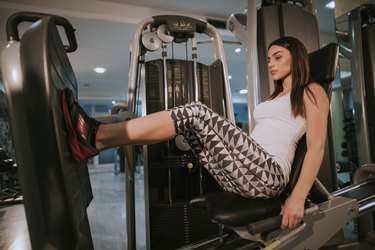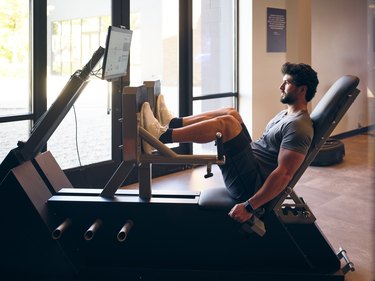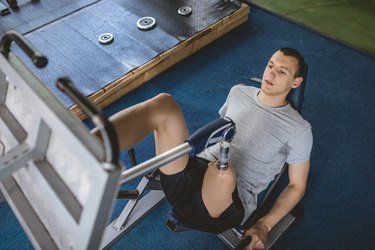

Yes, free weights are the foundation of a strong muscle-building plan, but if you want stronger thighs, the leg press machine also deserves a starring role.
"The leg press machine really works the leg muscles," says physical therapist Grayson Wickham, DPT, CSCS, founder of the Movement Vault. The leg press mainly works the quadriceps, but also strengthens the glutes, hamstrings, calves and shins.
Video of the Day
Below, Wickham breaks down exactly how to use the leg press machine with sound form, as well as the overall benefits of including the leg press in your strength-training routine.
What Is the Leg Press Machine?

A heavy-duty piece of equipment that allows individuals to train their hip and knee extensor muscles from a seated position, the leg press machine is sometimes called the seated leg press or machine squat press.
This hard-to-miss gym machine involves sitting down, then extending your hips and knees to press a weighted platform away from your body.
There are two main types of leg press machines, with the biggest difference being the direction you're pressing the weight.
1. Horizontal Leg Press
When using the horizontal seated leg press, you push the weight straight in front of you with your legs relatively parallel to the floor.
This set-up is most accessible to people who don't want to sit down close to the floor and have to get back up.
2. Incline Leg Press
With the incline press, your legs extend above your body at a 45-degree angle. While it may look more difficult than the horizontal version, it's actually not because you're not working against gravity, but rather a cable. However, this position requires sitting down very low and close to the floor.
Worth noting: It's often easier to keep your back flat against the pad during the incline press. This reduces the risk of form mistakes and resulting back pain.
How to Use the Leg Press Machine With Perfect Form
- Sit down on the leg press with your back and hips pressed against the seat.
- With your knees bent to 90 degrees or as far as comfortable, place your feet on the sled at hips-width apart. Brace your core.
- Keeping contact with the seat, exhale as you press through your entire foot to extend your legs.
- Once you begin to extend your legs, rotate the safety bars to allow for a greater range of motion.
- Continue pressing until just before your knees are locked out. Pause for one second.
- Return to the start position by bending your hips and knees.
- Rotate the safety bars back to their original position before returning to your starting position.
Tip
“Think about pulling your ribcage down your body throughout the entire movement to keep that midline activated,” Wickham says. If your core becomes loosey-goosey, it puts your spine into a suboptimal position that can stress your lower back.
Leg Press Muscles Worked
The leg press primarily strengthens your knee and hip extensors (aka your quads and glutes), but it also activates your hamstrings, calves and shins, Wickham says.
1. Quads
The main leg press muscles worked are the quadriceps, in the front of your thighs. This set of four muscles is in charge of straightening your knees to help you press the weight away from you.
In the leg press, the quads also work eccentrically to help you control the speed at which you bend your knees. Slow down each bend for the greatest benefit.
Also, to increase how hard your quads have to work, set up with your feet closer to the bottom edge of the platform, Wickham says.
2. Glutes
You can also get a glute workout with the leg press exercise because your butt muscles straighten your hips and stabilize your legs, Wickham says.
But because, in the leg press, you don't fully extend your hips, it alone won't significantly grow your glutes.
To get a little more glute involvement, set up with your feet closer to the top edge of the platform.
3. Hamstrings
The leg press also works your hamstrings, just to a lesser degree, Wickham says. These muscles assist in both bending your knees and straightening your hips.
The farther up your feet are on the platform, the greater the hamstring activation, he says.
4. Calves and Shins
Your lower-leg muscles help stabilize your legs and serve as the connection between your feet and thighs.
However, when doing leg presses, you shouldn't rise up onto your toes. Keep your feet flat on the platform at all times. With each rep, push through your heels and balls of your feet.
4 Leg Press Machine Benefits
1. It Builds Strength and Power
"The leg muscles that the leg press machine works are really powerful muscles, and strengthening them will increase power output and speed," Wickham says.
This is important for both running speed and increasing vertical jump.
2. It Lets You Train Around Upper-Body Injuries
Unlike many of the compound exercises that work the quads and leg muscles, the leg press machine does not require the use of your upper body, Wickham says.
This makes the leg press an ideal move for a lower-body workout that won't aggravate an existing upper-body injury.
3. It's Knee-Joint Friendly
As a general rule, the stronger the muscles around a joint are, the healthier a joint will be, according to Wickham. So, strengthening your quads — the upper leg muscle that connects to the knee — is good for your knee joints, he says.
Fortunately, even if you have frequent knee issues, the leg press machine is less likely than some free-weight lower-body exercises to cause pain. That's because it's a closed-chain exercise; your feet are stationary against the weight you're moving.
Does the leg press hurt your knees? You likely need to adjust your form. Try stepping your feet closer to the top edge of the platform.
4. It Can Help Ease Muscle Imbalances
Most people have a "strong" side and a "less strong" side. Long term, this can increase risk the of injury to both limbs, Wickham explains.
Doing single-leg, unilateral work on both legs can help reduce the strength gaps between your legs. But compound unilateral moves like single-leg squats can be very challenging.
That's where the leg press machine comes in. Drop the weight and you can do single-leg reps with the device.
The Difference Between Leg Presses and Squats
The leg press machine and squats strengthen the same lower-body muscles, but the leg press is a closed-chain exercise and the squat is an open-chained exercise (your upper body isn't stationary against the weight you're moving).
That means the leg press better isolates your quads while the squat involves more muscles throughout your lower, and even upper, body.
The leg machine's movement pattern also isn't as functional as the squat. After all, you do not need to leg press to stand up from the couch; you need to stand up from a squat.
So, if you're going to do one or the other, Wickman says the squat is generally more beneficial than the leg press.
However, if you're really invested in leg gains, doing both lower-body exercises can help you reap more benefits. To really work your leg muscles, you can even do the leg press at the end of your squat sets.
Was this article helpful?
150 Characters Max
0/150
Thank you for sharing!
Thank you for your feedback!


